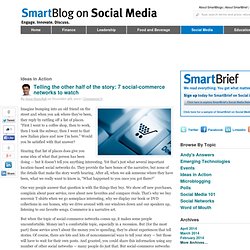

Social-shopping. Telling the other half of the story: 7 social-commerce networks to watch. Imagine bumping into an old friend on the street and when you ask where they’ve been, they reply by rattling off a list of places.

“First I went to a coffee shop, then to work, then I took the subway, then I went to that new Italian place and now I’m here.” Would you be satisfied with that answer? Hearing that list of places does give you some idea of what that person has been doing — but it doesn’t tell you anything interesting. Yet that’s just what several important location-based social networks do. They provide the bare bones of the narrative, but none of the details that make the story worth hearing.
One way people answer that question is with the things they buy. But when the topic of social-commerce networks comes up, it makes some people uncomfortable. Here’s a rundown of some of the players in the social-commerce space. Social Currency: If you like the idea of social-commerce networks and you’re into Foursquare, Social Currency might be the network for you.
Studie zu Conversion Rates: Produktauswahl als kritischer Moment. Bewertung: Studie zu Conversion Rates An welcher Stelle brechen Kaufwillige den den Onlineshop-Prozess ab? Das haben ECC Handel und Mücke, Sturm & Company untersucht und daraus Handlungsanweisungen abgeleitet. Die Produktauswahl ist der entscheidende Moment: Hier brechen 44,5 Prozent der potenziellen Kunden und immerhin von 11,2 Prozent der Bestandskunden den Kaufprozess ab (siehe Grafik). Abbruchraten beim Onlineshopping Von den möglichen Neukunden verabschieden 17,8 Prozent bereits schon auf der Startseite, 15,9 Prozent bei der Registrierung und 14,3 Prozent bei der Auswahl der Bezahlmethode. Um den Gesamtumsatz maximieren zu können, ist es der Studie "Shopmonitor Spezial Themenschwerpunkt Usability" zufolge für Onlineshops essentiell, die Kaufabbruchraten in allen Phasen des Kaufprozesses zu kennen und mit Hilfe geeigneter Maßnahmen zu minimieren.
Nach der eingehenden Analyse der Abbruchraten der 20 umsatzstärksten Onlineshops ergeben sich folgende Erkenntnisse: How to Use Facebook and Twitter to Drive Traffic to Your Retail Shop. I’m always surprised at how few retail spaces take advantage of Twitter and Facebook (yes, there are exceptions). The costs are low, the risks are manageable and your customers are already using the platforms. By engaging customers “where they live,” you can increase the foot traffic to your shop and grow your business. Here are 5 steps to grow your retail business using Facebook and Twitter. #1: Set Up Shop “80 percent of success is just showing up.” – Woody Allen This may sound obvious, but if you want to engage your customers and prospects on Twitter and Facebook, you have to be there.
On Twitter, this means creating an account for your business, but it also may mean creating an account for you or other people in your company. Twitter is a place for people, but it's also a place for businesses. On Facebook, setting up shop means creating a business page and claiming your Facebook Place (more on that later). Facebook business pages are great places to engage with your audience. Pre-Purchase Online Research Done by Nearly 60% of Americans.